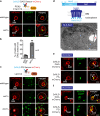Seipin governs phosphatidic acid homeostasis at the inner nuclear membrane
- PMID: 39622802
- PMCID: PMC11612446
- DOI: 10.1038/s41467-024-54811-z
Seipin governs phosphatidic acid homeostasis at the inner nuclear membrane
Abstract
The nuclear envelope is a specialized subdomain of the endoplasmic reticulum and comprises the inner and outer nuclear membranes. Despite the crucial role of the inner nuclear membrane in genome regulation, its lipid metabolism remains poorly understood. Phosphatidic acid (PA) is essential for membrane growth as well as lipid storage. Using a genome-wide lipid biosensor screen in S. cerevisiae, we identify regulators of inner nuclear membrane PA homeostasis, including yeast Seipin, a known mediator of nuclear lipid droplet biogenesis. Here, we show that Seipin preserves nuclear envelope integrity by preventing its deformation and ectopic membrane formation. Mutations of specific regions of Seipin, some linked to human lipodystrophy, disrupt PA distribution at the inner nuclear membrane and nuclear lipid droplet formation. Investigating the Seipin co-factor Ldb16 reveals that a triacylglycerol binding site is crucial for lipid droplet formation, whereas PA regulation can be functionally separated. Our study highlights the potential of lipid biosensor screens for examining inner nuclear membrane lipid metabolism.
© 2024. The Author(s).
Conflict of interest statement
Competing interests: The authors declare no competing interests.
Figures







Similar articles
-
Seipin is involved in the regulation of phosphatidic acid metabolism at a subdomain of the nuclear envelope in yeast.Biochim Biophys Acta. 2015 Nov;1851(11):1450-64. doi: 10.1016/j.bbalip.2015.08.003. Epub 2015 Aug 12. Biochim Biophys Acta. 2015. PMID: 26275961
-
Dissecting seipin function: the localized accumulation of phosphatidic acid at ER/LD junctions in the absence of seipin is suppressed by Sei1p(ΔNterm) only in combination with Ldb16p.BMC Cell Biol. 2015 Dec 4;16:29. doi: 10.1186/s12860-015-0075-3. BMC Cell Biol. 2015. PMID: 26637296 Free PMC article.
-
Mechanism of lipid droplet formation by the yeast Sei1/Ldb16 Seipin complex.Nat Commun. 2021 Oct 8;12(1):5892. doi: 10.1038/s41467-021-26162-6. Nat Commun. 2021. PMID: 34625558 Free PMC article.
-
Nuclear lipid droplet: Guardian of nuclear membrane lipid homeostasis?Curr Opin Cell Biol. 2024 Jun;88:102370. doi: 10.1016/j.ceb.2024.102370. Epub 2024 May 13. Curr Opin Cell Biol. 2024. PMID: 38744005 Review.
-
SEIPIN: A Key Factor for Nuclear Lipid Droplet Generation and Lipid Homeostasis.Int J Mol Sci. 2020 Nov 2;21(21):8208. doi: 10.3390/ijms21218208. Int J Mol Sci. 2020. PMID: 33147895 Free PMC article. Review.
Cited by
-
Sequential Targeting Chondroitin Sulfate-Bilirubin Nanomedicine Attenuates Osteoarthritis via Reprogramming Lipid Metabolism in M1 Macrophages.Adv Sci (Weinh). 2025 Mar;12(9):e2411911. doi: 10.1002/advs.202411911. Epub 2025 Jan 10. Adv Sci (Weinh). 2025. PMID: 39792653 Free PMC article.
-
Phosphatidic acid drives spatiotemporal distribution of Pex30 at ER-LD contact sites.J Cell Biol. 2025 Jul 7;224(7):e202405162. doi: 10.1083/jcb.202405162. Epub 2025 May 23. J Cell Biol. 2025. PMID: 40407416 Free PMC article.
References
Publication types
MeSH terms
Substances
LinkOut - more resources
Full Text Sources

